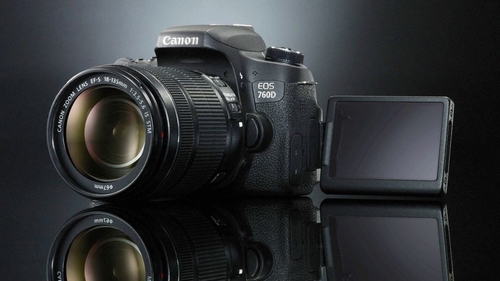The canon 760D was first launched in February 2015. An entry level DSLR, it features an APS-C sensor and forgoes some of the flashier elements similar to the 5Dc. As quoted by Canon in their release, “The EOS 760D is the first entrylevel EOS camera to incorporate a top LCD panel, in addition to the main display”. We got hold of a body with an 18-135mm lens for a review, let’s see how it performed.
Look body feel

The Canon EOS 760D is comparatively almost identical to the EOS 750D. It has the same 24.2-megapixel APS-C sensor, the same DIGIC 6 processor and the same AF system that provides hybrid focussing whether you’re using live view or the viewfinder as the EOS 750D. Although compared to the Canon EOS 700D, a few important improvements have been made across the board. Focus points have been upped form 9 to 19 and we get the DIGIC6 processor rather than DIGIC 5 for faster shooting and processing. An additional add-on is that Wi-Fi and NFC are included, unlike the 700D. There’s no need to buy pricey Wi-Fi adapter or wireless memory card anymore. It provides a sophisticated top LCD panel which displays important information such as ISO speed, exposure level and battery life. Much alike higher-ends cameras, operating the menus and settings in the EOS 760D is achieved through Quick Control Dial and Main Electronic Dial – an advanced method that allows users to adjust their settings and search for images with maximum convenience and minimal effort. The mode dial of the camera is pretty much the same; however the position of it allowed Canon to fit in an LCD display on the right part of the top plate, something which is generally a feature of a high-end pro DSLR. It lets you read exposure settings without activating the rear screen or looking through the viewfinder. The grip however is much more comfortable than the previous to carry. Mounted on a 50mm the camera bodyweight hardly feels anything. the pairing of an amazing sensor and the DIGIC 6 processor allows the user a standard sensitivity range of ISO 100 to12,800 equivalents which performs well in low-light conditions. For the price and the range the ISO performance is better than other equivalents in the market. The touch screen on the LCD also has good touch capability and calibration.
Performance

The Canon 760D uses 19-point, all cross-type autofocus sensor that’s inherited from the EOS 70D. It replaces the earlier 9-point, all cross-type phase detection autofocus sensor of the 750D,more than doubling the total number of points. The camera gives a Mac video resolution of 1920 x 1080. Together, the pairing of an amazing sensor and the DIGIC 6 processor allows the user a standard sensitivity range of ISO 100 to12,800 equivalents which performs well in low-light conditions. For the price and the range the ISO performance is better than other equivalents in the market. The touch screen on the LCD also has good touch capability and calibration.
ISO

The Canon EOS 760D offers you a native sensitivity range of ISO 100-12,800 with an expansion setting of ISO 25,600 for stills. It’s also possible for the cameras to set sensitivity automatically within the range ISO 100-6400.The native range for movies is ISO 100-6400with an expansion setting of ISO 12,800. The camera gives no or low noise at the higher ISO, and the noise control works well through the range. For more on how the camera performed check out the ISO chart.
The Canon EOS 760D offers you a native sensitivity range of ISO 100-12,800 with an expansion setting of ISO 25,600 for stills. It’s also possible for the cameras to set sensitivity automatically within the range ISO 100-6400.The native range for movies is ISO 100-6400with an expansion setting of ISO 12,800. The camera gives no or low noise at the higher ISO, and the noise control works well through the range. For more on how the camera performed check out the ISO chart.
Conclusion
Overall, this camera provides more than enough to the ones who want to go beyond the auto mode and explore. It’s fun and easy to use. The top LCD and Quick Mode Dial both make it worth the money you are paying for it. However, if you are looking for something basic and never going to switch out of your program mode than this might not be it.
Look, body and feel rating – 4 *
Light camera body, with touch screen and the all-new function button placement makes this camera very easy to use.
Performance rating – 4 *
With the new sensor and the functionality, the camera performance is as good as any semi-professional, entry-level full frame camera.
Overall rating – 4 *
It’s lighter in weight, like all the APS-C bodies from Canon. The performance and looks are close to any present entry-level full frames, which make this worth the buy for its cost.


